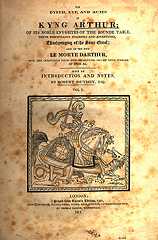July 31: The Age of Chivalry Exposed (1485)
Sir Thomas Malory's
Morte d'Arthur published (1485)
An “Age of Chivalry”?
It was on this date, July 31, 1485, that the source of the Arthurian legends as we know them today, eight romances known as Le Morte D'Arthur, was published in London.* The work was written by Sir Thomas Malory (c 1405-1471) and was published by the father of printing, William Caxton (1422?-1491). Malory is a mystery, but it seems he was himself a knight, and spent the last 20 years of his life in and out of prison for various crimes, such as extortion, robbery, poaching, and murder – hardly an exemplar of chivalry. Creed being valued more than conduct, Malory is of course claimed among the faithful by the Catholic Encyclopedia.
Malory completed his Morte D'Arthur while in prison, in 1469 or 1470. He died in 1471, so he never saw the first edition brought out by Caxton 14 years later. The Book of King Arthur and His Noble Knights of the Round Table, as Malory originally called it, shows off the religious and chivalric ideas of an age gone by – at least as its author imagined them.
The "Age of Chivalry," which has been relentlessly romanticized in pious literature, presumably lasted from 1100 to 1400 in England, France, Germany, Italy, and Spain. Chivalry in myth – especially as outlined by historian Léon Gautier in 1891 (see below) – was a time of deep religious faith, respect for the weak, bravery in battle, veneration of women, generosity of spirit, truth and justice.
The chivalric code, according to
Chivalry by Léon Gautier (1891):I. Thou shalt believe all that the Church teaches, and shalt observe all its directions.
II. Thou shalt defend the Church.
III. Thou shalt repect all weaknesses, and shalt constitute thyself the defender of them.
IV. Thou shalt love the country in the which thou wast born.
V. Thou shalt not recoil before thine enemy.
VI. Thou shalt make war against the Infidel without cessation, and without mercy.
VII. Thou shalt perform scrupulously thy feudal duties, if they be not contrary to the laws of God.
VIII. Thou shalt never lie, and shall remain faithful to thy pledged word.
IX. Thou shalt be generous, and give largess to everyone.
X. Thou shalt be everywhere and always the champion of the Right and the Good against Injustice and Evil.
Chivalry in fact was invented in the 1600s by two genealogists and sycophants to the French court: Jean Vulson de la Colombière and Claude-François Menestrier.** No contemporary chronicler mentions a knight-errant, the religious orders of knights (such as the Templars) never failed to become corrupt, and those who are touted as exemplars of chivalry – such as Richard the Lion-Heart and the Cid – were known to their contemporaries not as paragons of chivalry but as vicious and deceitful.
This may come as a revelation to those who think morality is on the decline in the world today, but during the “Age of Chivalry” the noble and knightly classes of both sexes were saturated with sexual vice and violence, brigandry and theft, and uncommon corruption. Serious scholars describe the age as the worst period for morals in the history of civilization.† And, of course, everyone went to church! You might conclude that if the “Age of Chivalry” was the apotheosis of Christianity, then gentle Jesus was a rascal.
* You can read the full text of Le Morte D'Arthur at this link.
** Vulson: Le vray théâtre d'honneur et de chevalerie ou le miroir héroique de la noblesse, 1648 ("The true theatre of honor and chivalry, or, the heroic mirror of nobility"); Menestrier: Histoire civile ou consulaire de la ville de Lyon, justifiée par chartres, titres, chroniques, manuscrits, autheurs anciens & modernes, & autres preuves, avec la carte de la ville, comme elle étoit il y a environ deux siécles, 1696 ("Civil history of the city of Lyon...").
† For conditions in Europe up to the 14th century, see the uncompleted General History of Civilization in Modern Europe by François Guizot, 1829-32 (tr. by William Hazlitt, 3 vol., 1846).
• For conditions in England, see the Catholic writer Hilaire Belloc, History of England, 4 vols., 1925; the Catholic historian John Lingard, History of England, 14 vols., 1823-31; Edward A. Freeman, Freeman's Historical Geography, edited by J.B. Bury, 1903; Henry Duff Traill's Social England, 4 vols., 1893-1898; The Cambridge Mediæval History, 7 vols., 1911-32.
• For France, see Achille Luchaire, Social France at the Time of Philip Augustus, Engl. trans., 1912; Ernest Lavisse, ed., Histoire de France depuis les origines jusqu'a la Révolution, 1901, vol. III.
• For Germany, see Wilhelm von Giesebrecht, Geschichte der deutschen Kaiserzeit, 6 vols., 1874-88; Albert Hauck, Kirchengeschichte Deutchlands, 5 vols., 1912; Rudolf Quanter, Die Sittlichkeitsverbrechen im Laufe der Jahrhunderte und ihre strafrechtliche Beurteilung, 1925; J. W. Thompson, Feudal Germany, 1928; H.A.L. Fisher Medieval Empire, 2 vols., 1898.
• For Italy, see John Addington Symonds, The Dantesque and Platonic Ideals of Love, 1893; Jakob Burckhardt, Die Kultur der Renaissance in Italien (The Civilization of the Renaissance in Italy), 1878; and Ferdinand Gregorovius, Geschichte der Stadt Rom im Mittelalter (Story of the City of Rome in the Middle Ages), 1896-1906.
• Special studies of chivalry include Joseph Anglade, Le Troubadour Guiraut Riquier; Étude sur la decadence de l'ancienne poesie provençale, 1909-1910; Léon Gautier (1832-1897), Chivalry: The Everyday Life of the Medieval Knight, 1891; John Frederick Rowbotham, The Troubadours and Courts of Love, 1895.
Originally published July 2003 by Ronald Bruce Meyer.


